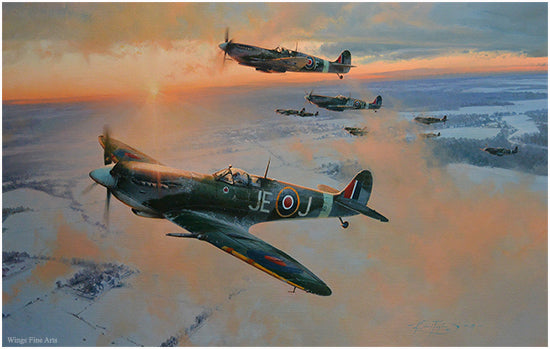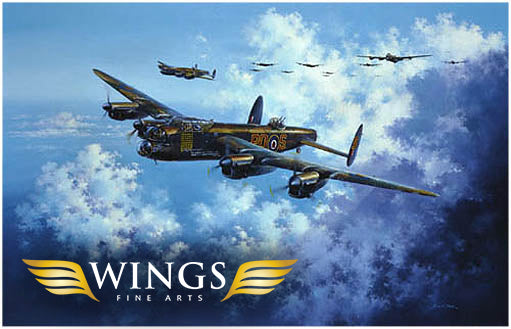Johnnie Johnson


James Edgar "Johnnie" Johnson tried, unsuccessfully, three times to join the R.A.F. in 1938. Eventually Johnnie Johnson began his pilot training in September of 1939 and was posted to 616 Spitfire Squadron during the Battle of Britain. After a few operational sorties, an old shoulder injury causing him considerable pain, threatened to either ground him or send him to Training Command. The choice was clear.
After a stay in hospital Johnnie Johnson was posted to his squadron in the Spring of 1941. When he arrived, he found that the Wing was commanded by the legendary legless ace Douglas Bader. Johnnie Johnson was an eager student and endeavored to learn as much as possible from this inspiring leader. "He taught us the true meaning of courage, spirit and determination" Johnnie explains after Douglas had become a POW. It was now our task to follow his signposts which pointed the way ahead".
Johnnie Johnson was given his first command, No. 610 Squadron, in July 1942. During the Dieppe raid, he flew four sorties, got one enemy fighter and shared another. This sortie almost proved to be his last as he was set upon by a FW 190 with Italian markings. Forbidden to fly below 2,000 feet (ships had been ordered to fire upon anything below this altitude) Johnnie dove and pulled out just above the ships masts. Anti-aircraft fire was intense but he pulled out unscathed. How the Italian FW 190 fared he never knew.
In March of 1943, Johnnie Johnnie was given command of the Kenley Spitfire Wing (Mk. 9's) which included two Canadian Squadrons. By September of 1943, his tally was 25 and the Canadian Kenley Wing accounted for 60 more victories.
After a six month rest, he was eager to get back on 'ops' and in March of 1944, Johnnie Johnson was given command of another Canadian Wing, No. 144 Wing, No. 83 Group of the 2nd Tactical Air Force which became No. 144 RCAF (Fighter) Wing, a fighter/bomber unit comprised of 441, 442 and 443 Squadrons. This Canadian Wing was the first unit to be based in Europe and to operate from France after D-Day.
Johnnie Johnson Becomes Leading Ace
By late June 1944, Johnnie Johnson surpassed the record 32 victories of "Sailor" Malan which was highly publicized by the press. Johnnie emphasized that "it was the duty of any leader to have their pilots destroy as many enemy aircraft as possible, not gain personal victories". "Teamwork was essential to ensure a maximum offensive and defensive effectiveness, flushing out and stalking the enemy to bring as many guns to bear as possible".

In early July the three Canadian Spitfire Wings, 126, 127 and 144 were formed into two Wings, Nos. 126 and 127 with Johnnie Johnson commanding 127 Wing comprised of 404, 441 and 442 Squadrons of the RCAF.
On August 23rd, Johnnie Johnson shot down two FW190s and his aircraft was hit for the first time by enemy fire. After the combat, he found himself separated from the Wing ( a most dangerous situation) and he proceeded to join a formation of six aircraft after a friendly wing waggle from its leader. He discovered too late that he had inadvertently joined up with a formation of Me109s! Miraculously he escaped by pulling up and climbing into the sun at full power. When the supercharger kicked in he got the extra boost of speed that he needed and he escaped safely but not without taking a cannon shell in his wing root. Upon returning to base he obtained another Spitfire and again went right back into combat.
On the 27th of September 1944, Johnnie Johnson dove out of the sun to claim his 38th and final aerial victory. Through 515 operational sorties he was fortunate enough to only be holed once.
In March of 1945, Johnnie Johnson was promoted to Group Captain and given command of No. 125 Wing (in an administrative role) but he often led the Wing or a Squadron. The Wing was equipped with the Spitfire Mk. XIV powered by the 2.050 hp Rolls Royce Griffon engine. This version, however, did not feel at all like a Spitfire with its propeller rotating in the opposite direction "it was both fast and powerful but it's not a Spitfire anymore" states Johnson.
In April 1945, Johnnie Johnson led the Wing over Berlin to only encounter Russian aircraft. A few days later the War in Europe ended
What is truly amazing about Johnnie Johnson's 'score' is that ALL 38 victories were against single engined fighters ranking him as the top-scoring Allied Ace of World War II. Johnson was one of the highest decorated pilots to emerge from the War and remained in the Air Force until his retirement in 1964 as A.O.C. Middle East Forces.
Author of several books on air-fighting Johnnie Johnson is today acknowledged as the leading expert on Air Power during World war II.
We do hope that you have enjoyed reading about the colorful history of 'my old man' and hope you take the opportuntiy to enjoy the very colorful world of Robert Taylor, Nicolas Trudgian, and other other successful aviation artists of the WINGS family.

